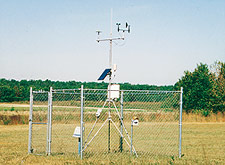
サウス ジャージー資源保全開発協議会が、地域の農家、そして後には地域の住宅所有者に迅速かつ便利な灌漑用水管理計画を提供するという課題に直面したとき、Campbell Scientific社 (CSI) がすぐにこの課題に取り組みました。それは 1993 年のことで、501(c)(3) 非営利団体である協議会は、Resource Information Serving Everyone (RISE) ネットワークの基盤を構築していました。このネットワークの主な焦点は農業用水保全であり、現在もそれが行われていますが、環境保護庁 (EPA) のスーパーファンド サイト付近の現物による地域水保全プロジェクトの要件を満たすという副次的な目的、および後に流域モデリングに取り組む目的が追加されたことで、多機能な事業へと成長しました。RISE ステーションは現在、ニュージャージー州南部の 11 郡のうち 8 郡に分散しています。現在、ニュージャージー州南部の大部分に広がる計 17 か所の気象観測所と 4 か所の水質観測所を擁する CSI は、水管理者、農家、住宅所有者、研究者が頼りにするシステムの中核を担っています。
RISE ネットワーク内の気象観測所は、CR10X 測定制御システムに基づいており、Vaisala HMP35C または HMP45C 温度湿度センサーで温度と湿度を、Li-Cor LI200S または LI200X 日射計で太陽エネルギーを、RM Young Wind Sentry Set で風速と風向を、TE525 または TE525WS 転倒枡雨量計で雨量を測定します。センサーは 60 秒ごとに測定され、出力は 1 時間ごと、6 時間ごと、および毎日行われます。条件付き出力は、イベント中の 6 分ごとの雨量を記録します。データは、各気象観測所に接続された電話モデムを介して毎日取得されます。
収集された気象データの利点を最大限に生かすため、評議会は各データロガーのプログラムにペンマン・モンティス蒸発散量 (ET) の式を組み込みました。これにより、各気象観測所の芝生で使用される水の量を概算できます。さまざまな研究者が開発した作物係数と、米国農務省天然資源保全局が計算した土壌水分値を使用して、ユーザーは特定の農作物に対する独自の灌漑用水管理コンセプトを開発できます。
ニュージャージー州の流域保護と管理の研究者にとって特に興味深いのは、ネットワークの降雨量測定です。具体的には、降雨時には 6 分間の降雨量のサブセットが出力されます。これにより、これまで入手できなかった降雨量の詳細なビューがお客様に提供されます。
真水の供給が急速に減少していることを受けて、議会は CSI システムが住宅所有者の節水プログラムに役立つかどうか尋ねられました。議会は地元の水道会社である United Water Toms River と協力して CSI 気象ステーションを設置し、住宅所有者を対象とした芝生散水プログラムの開発を支援しました。ET 量と、ホース先端または地中散水システムを稼働させるのに必要なおおよその時間 (分) が、地元のケーブル TV システム、ラジオ局 1 局、および地元の新聞に毎日提供されます。この活動により、この水道システム全体で夏のピーク時の毎日の水需要が 1 日あたり約 100 万ガロン削減されました。
RISE 気象ステーションがデータを記録すると、CSI の PC208W ソフトウェアにある一般的な SPLIT パラメータ ファイルなどの顧客開発フォームによって、データが管理しやすく読みやすくなります。
RISE ネットワークは、その発足以来、サウス ジャージー RC & D 協議会の課題である、地域の農家や住宅所有者に効果的な灌漑用水管理に必要な重要な情報を提供するという課題を大幅に軽減してきました。現在ではインターネット経由で簡単にアクセスできるこのシステムにより、協議会は多数の加入者がアクセスできるようにデータを瞬時に収集できるほか、地元のテレビ、新聞、ラジオ局の視聴者に非常に必要な灌漑情報を再放送できます。サウス ジャージー RC & D 協議会は、当初の目標を基に、資源保護に影響を与える可能性のある人々に有用で適切な情報を提供することを目指して、流域監視にまで範囲を拡大しました。気象データは環境監視のニーズの一部にすぎないと判断した協議会は、CSI 水質ステーションを選択して、その地域で必要な関連環境データを提供することで、その存在を拡大しました。
Campbell Scientific CR10X 測定および制御システムを使用する各水質ステーションには、VMT 水流速度センサー、pH プローブ、OBS3 濁度モニター、Oxyguard 溶存酸素プローブ、シャフト エンコーダー、Vaisala HMP45C 温度および湿度プローブ、TE525WS 傾斜バケット雨量計、および電話モデムが含まれます。
センサーの集合体により、各観測所はニュージャージー州カンバーランド郡のアッパー・コハンジー流域における水文学的ダイナミクスと人為的影響の明確な理解に貢献できるようになります。